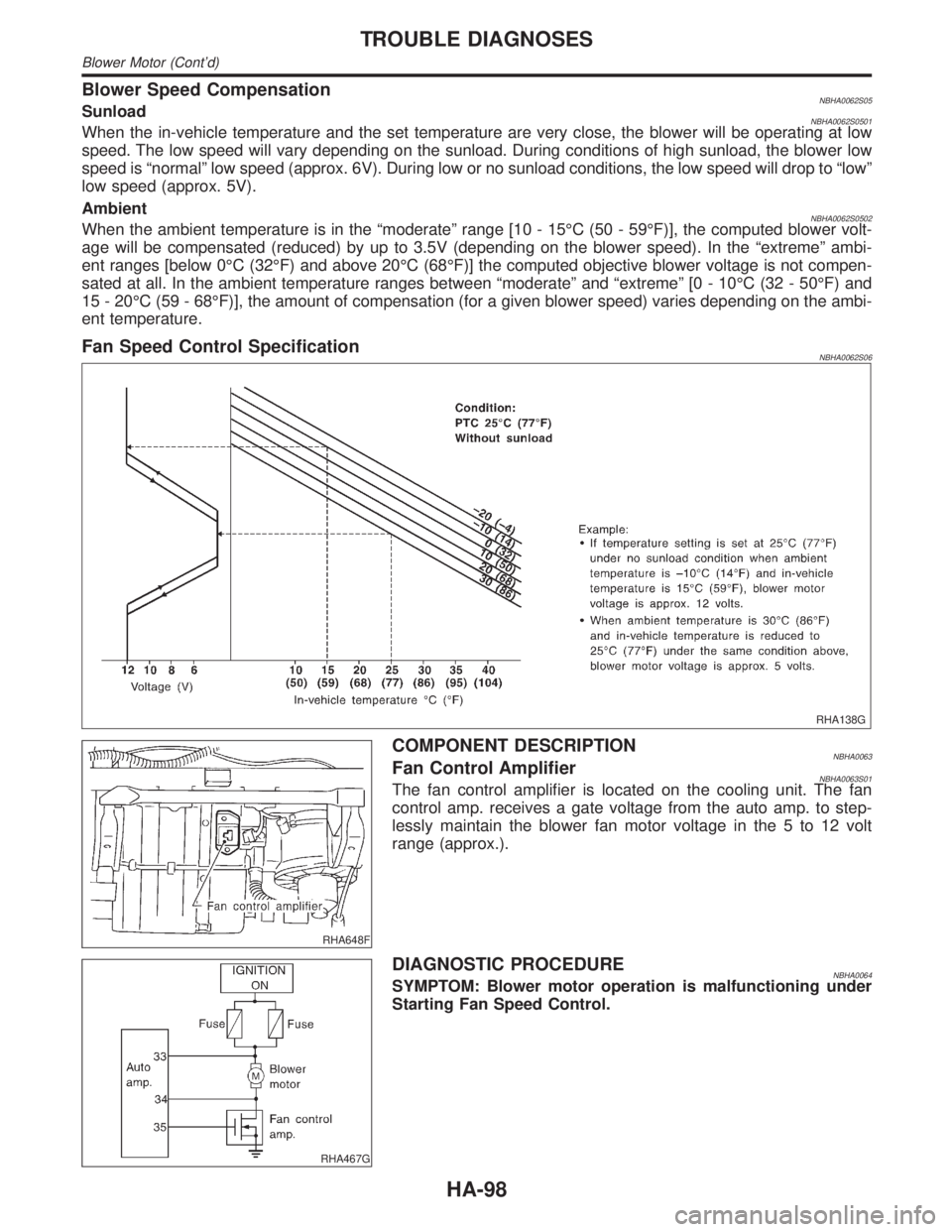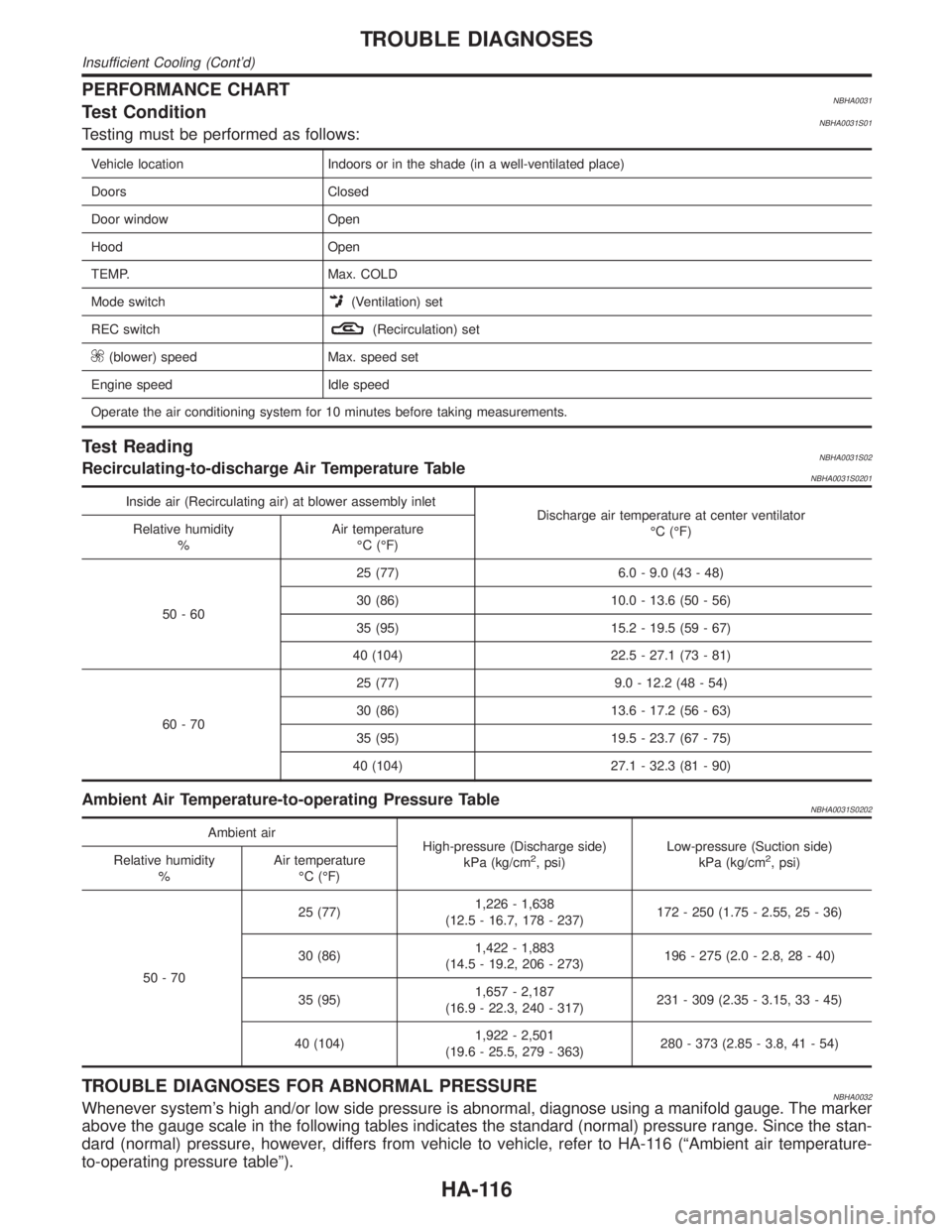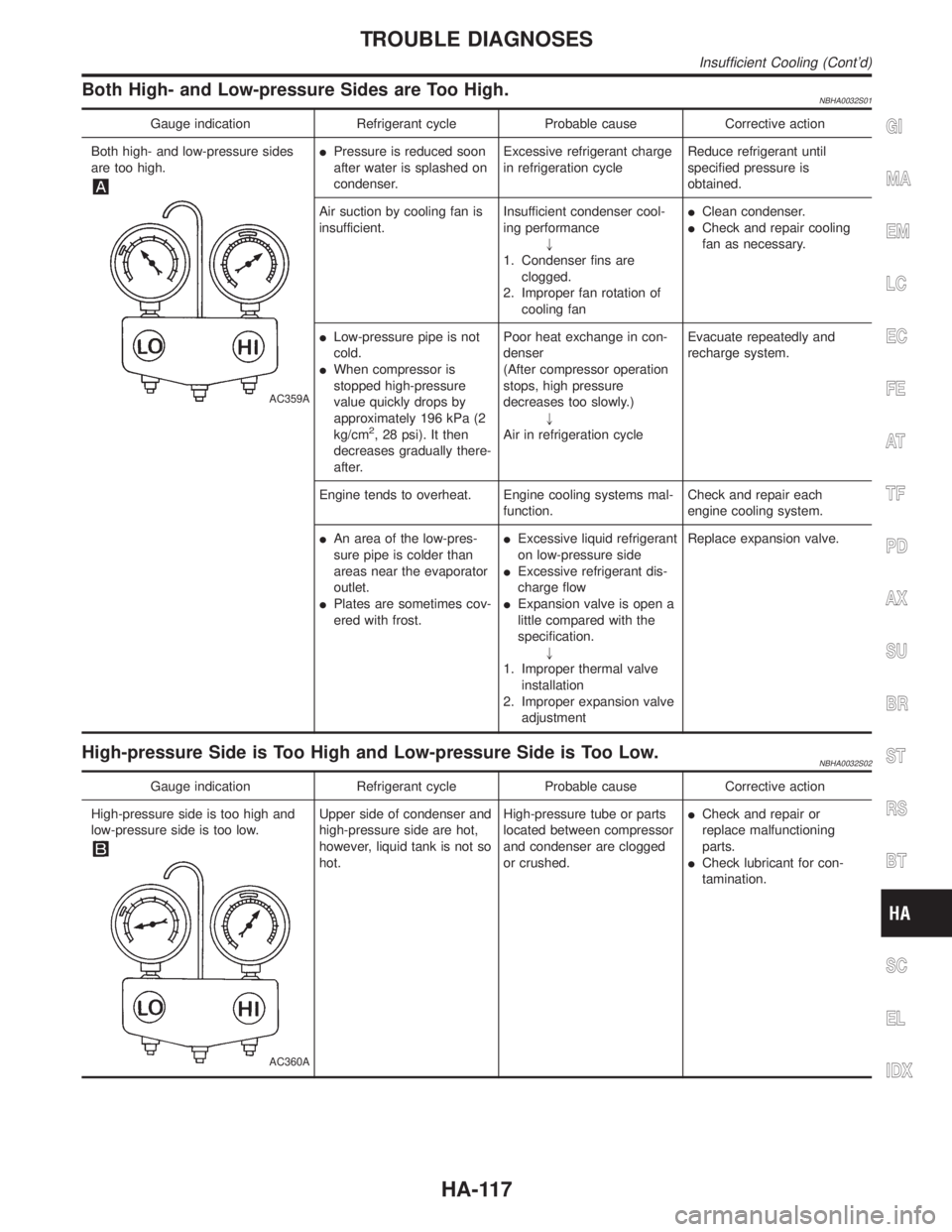Page 1897 of 2395

Blower Speed CompensationNBHA0062S05SunloadNBHA0062S0501When the in-vehicle temperature and the set temperature are very close, the blower will be operating at low
speed. The low speed will vary depending on the sunload. During conditions of high sunload, the blower low
speed is ªnormalº low speed (approx. 6V). During low or no sunload conditions, the low speed will drop to ªlowº
low speed (approx. 5V).
Ambient
NBHA0062S0502When the ambient temperature is in the ªmoderateº range [10 - 15ÉC (50 - 59ÉF)], the computed blower volt-
age will be compensated (reduced) by up to 3.5V (depending on the blower speed). In the ªextremeº ambi-
ent ranges [below 0ÉC (32ÉF) and above 20ÉC (68ÉF)] the computed objective blower voltage is not compen-
sated at all. In the ambient temperature ranges between ªmoderateº and ªextremeº [0 - 10ÉC (32 - 50ÉF) and
15 - 20ÉC (59 - 68ÉF)], the amount of compensation (for a given blower speed) varies depending on the ambi-
ent temperature.
Fan Speed Control SpecificationNBHA0062S06
RHA138G
RHA648F
COMPONENT DESCRIPTIONNBHA0063Fan Control AmplifierNBHA0063S01The fan control amplifier is located on the cooling unit. The fan
control amp. receives a gate voltage from the auto amp. to step-
lessly maintain the blower fan motor voltage in the 5 to 12 volt
range (approx.).
RHA467G
DIAGNOSTIC PROCEDURENBHA0064SYMPTOM: Blower motor operation is malfunctioning under
Starting Fan Speed Control.
TROUBLE DIAGNOSES
Blower Motor (Cont'd)
HA-98
Page 1911 of 2395
Insufficient Cooling
TROUBLE DIAGNOSIS PROCEDURE FOR INSUFFICIENT COOLING=NBHA0096SYMPTOM:
IInsufficient cooling
Inspection FlowNBHA0096S01Without Navigation SystemNBHA0096S0101
SHA190FC
*1: HA-44
*2: HA-85
*3: HA-116
*4: HA-53
*5: STEP-BY-STEP PROCEDURE
(HA-45), see No. 13.*6: HA-77
*7: HA-89
*8: HA-97
*9: HA-106
*10: HA-114*11: HA-66
*12: HA-45
*13: HA-2
*14: MA-13
*15: LC-20
TROUBLE DIAGNOSES
Insufficient Cooling
HA-112
Page 1912 of 2395
With Navigation SystemNBHA0096S0102
RHA881H
*1: HA-44
*2: HA-85
*3: HA-116
*4: HA-53
*5: STEP-BY-STEP PROCEDURE
(HA-45), see No. 13.*6: HA-77
*7: HA-89
*8: HA-97
*9: HA-106
*10: HA-114*11: HA-66
*12: HA-45
*13: HA-2
*14: MA-13
*15: LC-20
GI
MA
EM
LC
EC
FE
AT
TF
PD
AX
SU
BR
ST
RS
BT
SC
EL
IDX
TROUBLE DIAGNOSES
Insufficient Cooling (Cont'd)
HA-113
Page 1913 of 2395
PERFORMANCE TEST DIAGNOSESNBHA0030
SHA893E
*1: HA-116
*2: HA-116*3: HA-116
*4: HA-85*5: HA-85
TROUBLE DIAGNOSES
Insufficient Cooling (Cont'd)
HA-114
Page 1914 of 2395
RHA576H
*1: HA-149 *2: HA-95 *3: MA-13
GI
MA
EM
LC
EC
FE
AT
TF
PD
AX
SU
BR
ST
RS
BT
SC
EL
IDX
TROUBLE DIAGNOSES
Insufficient Cooling (Cont'd)
HA-115
Page 1915 of 2395

PERFORMANCE CHARTNBHA0031Test ConditionNBHA0031S01Testing must be performed as follows:
Vehicle location Indoors or in the shade (in a well-ventilated place)
Doors Closed
Door window Open
Hood Open
TEMP. Max. COLD
Mode switch
(Ventilation) set
REC switch
(Recirculation) set
(blower) speed Max. speed set
Engine speed Idle speed
Operate the air conditioning system for 10 minutes before taking measurements.
Test ReadingNBHA0031S02Recirculating-to-discharge Air Temperature TableNBHA0031S0201
Inside air (Recirculating air) at blower assembly inlet
Discharge air temperature at center ventilator
ÉC (ÉF) Relative humidity
%Air temperature
ÉC (ÉF)
50-6025 (77) 6.0 - 9.0 (43 - 48)
30 (86) 10.0 - 13.6 (50 - 56)
35 (95) 15.2 - 19.5 (59 - 67)
40 (104) 22.5 - 27.1 (73 - 81)
60-7025 (77) 9.0 - 12.2 (48 - 54)
30 (86) 13.6 - 17.2 (56 - 63)
35 (95) 19.5 - 23.7 (67 - 75)
40 (104) 27.1 - 32.3 (81 - 90)
Ambient Air Temperature-to-operating Pressure TableNBHA0031S0202
Ambient air
High-pressure (Discharge side)
kPa (kg/cm
2, psi)Low-pressure (Suction side)
kPa (kg/cm2, psi) Relative humidity
%Air temperature
ÉC (ÉF)
50-7025 (77)1,226 - 1,638
(12.5 - 16.7, 178 - 237)172 - 250 (1.75 - 2.55, 25 - 36)
30 (86)1,422 - 1,883
(14.5 - 19.2, 206 - 273)196 - 275 (2.0 - 2.8, 28 - 40)
35 (95)1,657 - 2,187
(16.9 - 22.3, 240 - 317)231 - 309 (2.35 - 3.15, 33 - 45)
40 (104)1,922 - 2,501
(19.6 - 25.5, 279 - 363)280 - 373 (2.85 - 3.8, 41 - 54)
TROUBLE DIAGNOSES FOR ABNORMAL PRESSURENBHA0032Whenever system's high and/or low side pressure is abnormal, diagnose using a manifold gauge. The marker
above the gauge scale in the following tables indicates the standard (normal) pressure range. Since the stan-
dard (normal) pressure, however, differs from vehicle to vehicle, refer to HA-116 (ªAmbient air temperature-
to-operating pressure tableº).
TROUBLE DIAGNOSES
Insufficient Cooling (Cont'd)
HA-116
Page 1916 of 2395

Both High- and Low-pressure Sides are Too High.NBHA0032S01
Gauge indication Refrigerant cycle Probable cause Corrective action
Both high- and low-pressure sides
are too high.
AC359A
IPressure is reduced soon
after water is splashed on
condenser.Excessive refrigerant charge
in refrigeration cycleReduce refrigerant until
specified pressure is
obtained.
Air suction by cooling fan is
insufficient.Insufficient condenser cool-
ing performance
"
1. Condenser fins are
clogged.
2. Improper fan rotation of
cooling fanIClean condenser.
ICheck and repair cooling
fan as necessary.
ILow-pressure pipe is not
cold.
IWhen compressor is
stopped high-pressure
value quickly drops by
approximately 196 kPa (2
kg/cm
2, 28 psi). It then
decreases gradually there-
after.Poor heat exchange in con-
denser
(After compressor operation
stops, high pressure
decreases too slowly.)
"
Air in refrigeration cycleEvacuate repeatedly and
recharge system.
Engine tends to overheat. Engine cooling systems mal-
function.Check and repair each
engine cooling system.
IAn area of the low-pres-
sure pipe is colder than
areas near the evaporator
outlet.
IPlates are sometimes cov-
ered with frost.IExcessive liquid refrigerant
on low-pressure side
IExcessive refrigerant dis-
charge flow
IExpansion valve is open a
little compared with the
specification.
"
1. Improper thermal valve
installation
2. Improper expansion valve
adjustmentReplace expansion valve.
High-pressure Side is Too High and Low-pressure Side is Too Low.NBHA0032S02
Gauge indication Refrigerant cycle Probable cause Corrective action
High-pressure side is too high and
low-pressure side is too low.
AC360A
Upper side of condenser and
high-pressure side are hot,
however, liquid tank is not so
hot.High-pressure tube or parts
located between compressor
and condenser are clogged
or crushed.ICheck and repair or
replace malfunctioning
parts.
ICheck lubricant for con-
tamination.
GI
MA
EM
LC
EC
FE
AT
TF
PD
AX
SU
BR
ST
RS
BT
SC
EL
IDX
TROUBLE DIAGNOSES
Insufficient Cooling (Cont'd)
HA-117
Page 1917 of 2395
High-pressure Side is Too Low and Low-pressure Side is Too High.NBHA0032S03
Gauge indication Refrigerant cycle Probable cause Corrective action
High-pressure side is too low and
low-pressure side is too high.
AC356A
High and low-pressure sides
become equal soon after
compressor operation stops.Compressor pressure opera-
tion is improper.
"
Damaged inside compressor
packingsReplace compressor.
No temperature difference
between high and low-pres-
sure sidesCompressor pressure opera-
tion is improper.
"
Damaged inside compressor
packings.Replace compressor.
TROUBLE DIAGNOSES
Insufficient Cooling (Cont'd)
HA-118